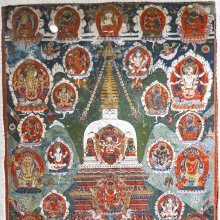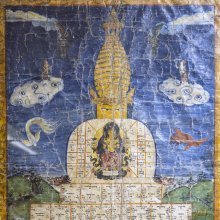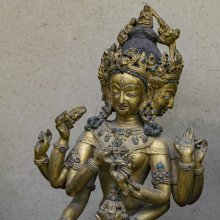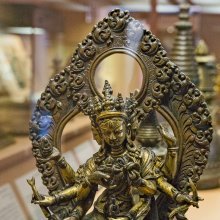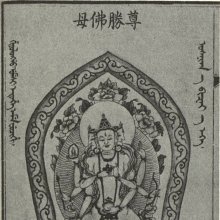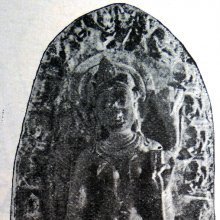Ushnishavijaya, Uṣṇīṣavijayā, Ushnisha-vijaya: 5 definitions
Introduction:
Ushnishavijaya means something in Buddhism, Pali, Hinduism, Sanskrit. If you want to know the exact meaning, history, etymology or English translation of this term then check out the descriptions on this page. Add your comment or reference to a book if you want to contribute to this summary article.
The Sanskrit term Uṣṇīṣavijayā can be transliterated into English as Usnisavijaya or Ushnishavijaya, using the IAST transliteration scheme (?).
Images (photo gallery)
(+15 more images available)
In Buddhism
Tibetan Buddhism (Vajrayana or tantric Buddhism)
Source: archive.org: The Indian Buddhist Iconography1) Uṣṇīṣavijayā (उष्णीषविजया) refers to one of the emanations of Vairocana, as mentioned in the 5th-century Sādhanamālā (a collection of sādhana texts that contain detailed instructions for rituals).—Her Colour is white; her Identification mark is Buddha on lotus; she has three faces and eight arms.—Like Mārīcī, Uṣṇiīavijayā is also said to bear the image of Vairocana on her feet crown and to reside within the womb of a Caitya. She is one of the most-popular deities of the pantheon, and almost every temple in Nepal contains her image.
The Dhyāna (meditation instructions) of Aśokakāntā described in the Sādhanamālā as follows:—
“The worshipper should conceive himself as (Uṣṇiīavijayā) who is white in complexion, three-faced, three-eyed, youthful and is decked in many ornaments. Her right and left faces are respectively of yellow and blue colour. Her four right hands display the viśvavajra. Buddha on lotus, the arrow and the varada pose, and her four left hands show the bow, the noose with the tarjanī, the abhaya pose and the well-filled water vessel. She resides in the womb of the Caitya, and bears the image of Vairocana on the crown. Thus meditating...”.
The most artistic specimen belongs to the Indian Museum, Calcutta. A miniature Caitya on the top of the image of Uṣṇiīavijayā signifies that she is an offspring of Vairocana who resides in the centre of the Caitya. It is not improbable that Uṣṇiīavijayā is the deified form of the Dhāriṇī of the same name included in the group of twelve Dhāriṇī goddesses. She may thus represent the deified form of the Uṣṇiīavijayā Dhāriṇī.
2) Uṣṇīṣavijayā (उष्णीषविजया) refers to one of the twelve Dhāriṇīs according to the 11th-century Niṣpannayogāvalī of Mahāpaṇḍita Abhayākara.—Dhāriṇī is a peculiar kind of Buddhist literature which is supposed to generate great mystic power if repeated continually for a long time. They are short works mostly composed of meaningless syllables, sometimes revealing traces of a language now defunct. [...] The deification of books is not unknown in Buddhism. [...] The Niṣpannayogavālī acknowledges altogether twelve Dhāriṇī (viz., Uṣṇīṣavijayā) deities and gives their descriptions. These Dhāriṇīs look alike when represented and they are usually two-armed, holding the Viśvavajra in the right hand and their special symbols in the left.
Uṣṇīṣavijayā is described in the Niṣpannayogāvalī (dharmadhātuvāgīśvara-maṇḍala) as follows:—
“Uṣṇīṣavijayā is white in colour and holds in her left hand a jar full of Moonstones”.
[Her Colour is white; her Symbol is the jar of moonstones; she has two arms.—When conceived in the form of deities, the Dhāriṇīs (viz., Uṣṇīṣavijayā) are endowed with one face and two arms. They all hold in their right hand the double thunderbolt or the viśvavajra, while in the left they carry their own special symbols.]
3) Uṣṇīṣavijayā (उष्णीषविजया) also refers to one of the ten Goddesses of the Vajratārāmaṇḍala belonging to Vajratārā: one of the various emanations of Ratnasambhava.—Accordingly, the sādhana further says that the Guardians of the Gates should also be meditated upon as around the principal Goddess, but apparently not in the same circle with the [four cardinal Goddess]:—“Goddess Uṣṇīṣavijayā occupies the upper regions”.
All these Goddesses [viz., Uṣṇīṣavijayā] stand on the orb of the sun in the ālīḍha attitude with the right leg stretched forward. They are radiant like the Sun-god and are surrounded with a fiery halo. They are decked in ornaments of snakes. [...] These Goddesses originate from the ten different letters of the mantra of Vajratārā, which is “oṃ tāre tuttāre ture svāhā”, consisting of ten syllables. Each syllable brings forth a Goddess, and these Goddesses are said to be the embodiments of the ten paramitas of the Mahāyāna School.
4) Uṣṇīṣavijayā (उष्णीषविजया) presides over the Upper region and represents one of the six Goddesses of the directions, according to the same Niṣpannayogāvalī.—Her Colour is white; her Symbol is the discuss; she has one face and two arms.—The fifth goddess in the series is Uṣṇīṣavijayā who is the presiding deity of the Upper region.
Uṣṇīṣavijayā is described in Niṣpannayogāvalī (vajratārāmaṇḍala) and Sādhanamālā (vajratārāsādhana) as follows:—
Source: Rangjung Yeshe Wiki: Dharma Dictionary“In the upper region there is goddess Uṣṇīṣavijayā, white in colour, holding the Discus in her right hand”.
[The left hand of the goddess displays as usual the raised index finger.]
Uṣṇīṣavijaya (उष्णीषविजय) or Uṣṇīṣavijayatārā (in Tibetan: གཙུག་ཏོར་རྣམ་པར་རྒྱལ་མའི་སྒྲོལ་མ) refers to the “Tārā who is the Victorious Uṣṇīṣa” and represents one of the twenty-one emanations of Tārā according to the Kashmiri Mahasiddha Suryagupta Tradition.—Suryagupta or Ravigupta (Tibetan: nyi ma be pa) was a layperson from Kashmir that was cured of leprosy by a miraculous statue of the goddess Tara. Suryagupta is famous for having many visions of Tara and originating many lineages of her practice such as the Twenty-one forms of Tara [e.g., Uṣṇīṣa-vijayatārā]. There exists inscriptions and paintings (from the 14th century) of these Twenty-one Taras and they are also described in ritual and meditation texts in both Sanskrit and Tibetan language.

Tibetan Buddhism includes schools such as Nyingma, Kadampa, Kagyu and Gelug. Their primary canon of literature is divided in two broad categories: The Kangyur, which consists of Buddha’s words, and the Tengyur, which includes commentaries from various sources. Esotericism and tantra techniques (vajrayāna) are collected indepently.
General definition (in Buddhism)
Source: Cambridge Digital Library: Pañcarakṣā, SaptavāraUṣṇīṣavijayā (उष्णीषविजया) refers to the fourth of “seven days” (saptavāra) classified as a dhāraṇī according to a 17th-century Sanskrit manuscript from Nepal .—This collection associates each dhāraṇī with a specific day of the week, a tradition going back to at least the sixteenth century in Nepal.
Languages of India and abroad
Sanskrit dictionary
Source: Cologne Digital Sanskrit Dictionaries: Edgerton Buddhist Hybrid Sanskrit DictionaryUṣṇīṣavijayā (उष्णीषविजया).—name of a goddess: Sādhanamālā 180.7 etc.
Source: Cologne Digital Sanskrit Dictionaries: Monier-Williams Sanskrit-English Dictionary1) Uṣṇīṣavijaya (उष्णीषविजय):—[=uṣṇīṣa-vijaya] [from uṣṇīṣa > uṣ] m. a [particular] prayer, [Buddhist literature]
2) Uṣṇīṣavijayā (उष्णीषविजया):—[=uṣṇīṣa-vijayā] [from uṣṇīṣa-vijaya > uṣṇīṣa > uṣ] f. a Tantra deity, ibidem
Sanskrit, also spelled संस्कृतम् (saṃskṛtam), is an ancient language of India commonly seen as the grandmother of the Indo-European language family (even English!). Closely allied with Prakrit and Pali, Sanskrit is more exhaustive in both grammar and terms and has the most extensive collection of literature in the world, greatly surpassing its sister-languages Greek and Latin.
See also (Relevant definitions)
Partial matches: Ushnisha, Vijaya.
Starts with: Ushnishavijayatara.
Full-text: Saptavara, Vajrataramandala, Dharini.
Relevant text
Search found 2 books and stories containing Ushnishavijaya, Uṣṇīṣavijayā, Ushnisha-vijaya, Uṣṇīṣa-vijayā, Usnisavijaya, Usnisa-vijaya, Uṣṇīṣavijaya, Uṣṇīṣa-vijaya; (plurals include: Ushnishavijayas, Uṣṇīṣavijayās, vijayas, vijayās, Usnisavijayas, Uṣṇīṣavijayas). You can also click to the full overview containing English textual excerpts. Below are direct links for the most relevant articles:
Related products
